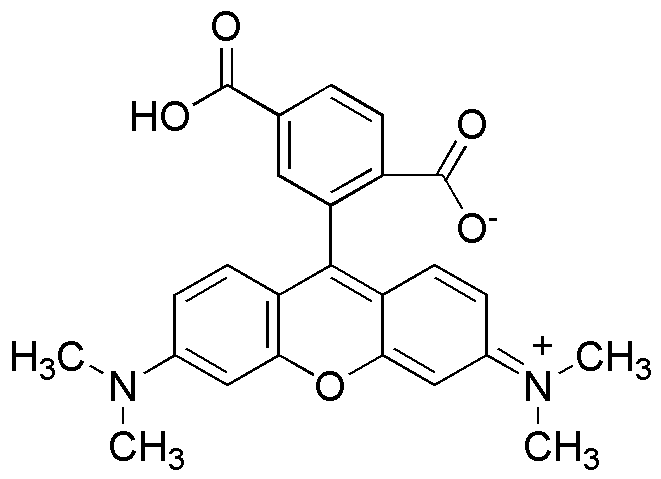6-Carboxy-tetramethylrhodamine is widely utilized in research focused on:
- Fluorescent Labeling: This compound is commonly used as a fluorescent dye in biological research, allowing scientists to label and visualize proteins, nucleic acids, and other biomolecules in live cells.
- Flow Cytometry: It serves as a vital tool in flow cytometry applications, enabling the analysis of cell populations based on their fluorescence characteristics, which is crucial for immunology and cancer research.
- Immunohistochemistry: Researchers employ it in immunohistochemical staining to detect specific antigens in tissue samples, aiding in the diagnosis of diseases and understanding tissue architecture.
- Environmental Monitoring: The compound can be used in environmental studies to track pollutants or biological markers in water samples, providing insights into ecosystem health.
- Drug Development: In pharmaceutical research, it assists in the development of targeted drug delivery systems, where its fluorescent properties help in monitoring drug release and distribution in biological systems.
Informations générales
Propriétés
Sécurité et réglementation
Applications
6-Carboxy-tetramethylrhodamine is widely utilized in research focused on:
- Fluorescent Labeling: This compound is commonly used as a fluorescent dye in biological research, allowing scientists to label and visualize proteins, nucleic acids, and other biomolecules in live cells.
- Flow Cytometry: It serves as a vital tool in flow cytometry applications, enabling the analysis of cell populations based on their fluorescence characteristics, which is crucial for immunology and cancer research.
- Immunohistochemistry: Researchers employ it in immunohistochemical staining to detect specific antigens in tissue samples, aiding in the diagnosis of diseases and understanding tissue architecture.
- Environmental Monitoring: The compound can be used in environmental studies to track pollutants or biological markers in water samples, providing insights into ecosystem health.
- Drug Development: In pharmaceutical research, it assists in the development of targeted drug delivery systems, where its fluorescent properties help in monitoring drug release and distribution in biological systems.
Documents
Fiches de données de sécurité (FDS)
La FDS fournit des informations de sécurité complètes sur la manipulation, le stockage et l’élimination du produit.
Spécifications du produit (PS)
Le PS fournit une description complète des propriétés du produit, notamment sa composition chimique, son état physique, sa pureté et les exigences de stockage. Il détaille également les plages de qualité acceptables et les applications prévues du produit.
Certificats d'analyse (COA)
Recherchez des certificats d'analyse (COA) en saisissant le numéro de lot du produit. Les numéros de lot et de lot se trouvent sur l'étiquette d'un produit, après les mots « Lot » ou « Lot de fabrication ».
Numéro de catalogue
Numéro de lot/série
Certificats d'origine (COO)
Ce certificat d'exploitation confirme le pays dans lequel le produit a été fabriqué, et détaille également les matériaux et composants utilisés et s'il est issu de sources naturelles, synthétiques ou autres sources spécifiques. Ce certificat peut être requis pour les douanes, le commerce et la conformité réglementaire.
Numéro de catalogue
Numéro de lot/série
Fiches de données de sécurité (FDS)
La FDS fournit des informations de sécurité complètes sur la manipulation, le stockage et l’élimination du produit.
DownloadSpécifications du produit (PS)
Le PS fournit une description complète des propriétés du produit, notamment sa composition chimique, son état physique, sa pureté et les exigences de stockage. Il détaille également les plages de qualité acceptables et les applications prévues du produit.
DownloadCertificats d'analyse (COA)
Recherchez des certificats d'analyse (COA) en saisissant le numéro de lot du produit. Les numéros de lot et de lot se trouvent sur l'étiquette d'un produit, après les mots « Lot » ou « Lot de fabrication ».
Numéro de catalogue
Numéro de lot/série
Certificats d'origine (COO)
Ce certificat d'exploitation confirme le pays dans lequel le produit a été fabriqué, et détaille également les matériaux et composants utilisés et s'il est issu de sources naturelles, synthétiques ou autres sources spécifiques. Ce certificat peut être requis pour les douanes, le commerce et la conformité réglementaire.


